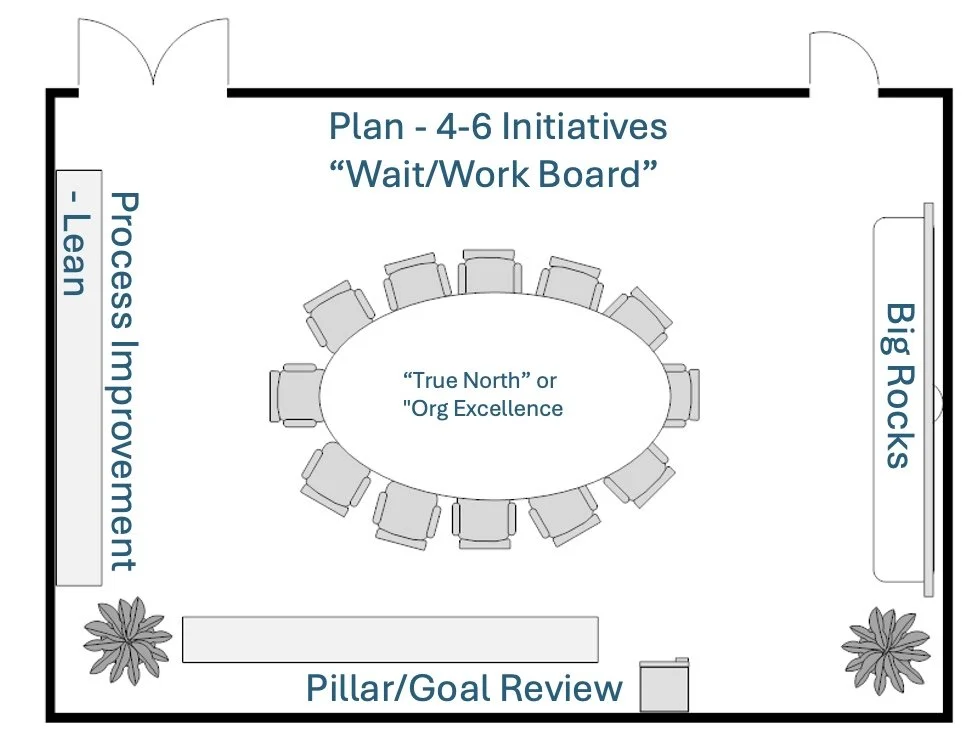Managing People, Process, and Plan - A Systematic Approach to Organizational Success
In many healthcare organizations, the key to achieving success lies in effectively managing People, Process, and Plan. To truly harness this triad, it requires a disciplined, structured approach that keeps the entire team aligned with the organization’s mission, strategic goals, and improvement initiatives. One highly effective method for maintaining this alignment and keeping progress on track is what I call the "Around-the-Room Review."
This blog will explore how to set up a structured review process by utilizing the physical layout of a room to track progress and address key strategic priorities in a systematic way.
This blog will explore how to set up a structured review process by utilizing the physical layout of a room to track progress and address key strategic priorities in a systematic way.
The Around-the-Room Review Process
The room is laid out in a way that allows the organization’s leadership team to walk through each key element of the strategy and operational focus, ensuring every strategic initiative, goal, and improvement project gets attention. This review happens 1-2 times per month, ensuring that we stay focused on the right things at the right time. Let's take a closer look at each wall in the review process:
North Wall: Reviewing Strategic Initiatives and the Wait/Work Board
The review process begins with the north wall, where we focus on our strategic initiatives and their respective A3 documents. Each A3 serves as a one-page project overview, laying out the purpose, problem statement, analysis, countermeasures, and progress indicators for each initiative.
We conduct an in-depth review of each initiative to ensure we are on track. Key questions we address include:
Are the countermeasures effective?
Do we need additional resources to meet the goals of this initiative?
What obstacles are slowing progress, and how can we overcome them?
After reviewing the strategic initiatives, we move to the Wait/Work Board. This board houses ideas that are currently "waiting" to be initiated, as well as those in the "work" phase. This helps prioritize initiatives based on capacity and organizational needs, ensuring a balanced pipeline of projects.
East Wall: Big Rocks and Capacity Management
Next, we shift to the east wall, where we focus on what we call the “Big Rocks.” These are the major initiatives that consume substantial resources and capacity, often spanning multiple departments. Here, we take a detailed look at timelines, interdependencies, and our organization's capacity to take on new work.
Questions to consider:
Are our Big Rocks on schedule, or do timelines need adjustments?
How are we balancing our capacity for new work versus ongoing commitments?
Do we need to reallocate resources or adjust staffing to maintain momentum?
South Wall: Reviewing Progress Against Pillars and Departmental Goals
The south wall is dedicated to tracking progress against our organizational Pillars. We typically have 4-5 key Pillars (e.g., quality, employee engagement, patient satisfaction, finance, and community), each with several overarching goals. Each department also has specific goals aligned with these Pillars.
In this part of the review, we assess:
Are we making measurable progress towards our Pillar goals?
Which goals are lagging, and what support do departments need?
How are individual departments contributing to these broader goals?
We also conduct a department-by-department review, focusing on how each team is progressing in meeting their goals. This review encourages cross-departmental collaboration and accountability.
West Wall: People and Process Improvement Projects
Lastly, we turn to the west wall, which is dedicated to reviewing our People and Process improvement projects. This wall typically contains 25-30 active improvement initiatives, focusing on Lean Process Improvement efforts that drive efficiency, quality, and patient experience.
In addition to Process improvement projects, we take time to review the work of our various committees dedicated to People-focused areas such as workplace wellness, employee engagement, community involvement, and staff development. Each committee provides a report, highlighting key activities, progress, and outcomes. This systematic check-in allows us to connect the efforts of these committees with our larger organizational goals.
For each committee, we review:
Workplace Wellness: How are the wellness programs impacting employee satisfaction and well-being?
Community Involvement: What initiatives are underway to engage and support our local community?
Staff Development: Are training and development programs meeting the needs of staff and aligning with strategic objectives?
Volunteerism and Engagement: How are our engagement efforts helping staff connect their work with organizational values?
This portion of the review helps us maintain a healthy organizational culture by ensuring that our People-focused initiatives are aligned with our strategic goals and that every area is receiving the support it needs.
Staying on Track with Regular Reviews
This systematic approach provides structure and consistency, allowing us to stay focused on meeting our annual goals. By holding 1-2 review sessions per month, the leadership team can ensure that key initiatives remain on track, that Big Rocks are progressing as planned, and that improvement projects receive the attention they need.
Why This Approach Works
The strength of this review process lies in its visual and collaborative nature. By using the walls to represent different focal points, the leadership team can maintain a shared understanding of progress and challenges. The systematic rotation from wall to wall ensures that every key element of People, Process, and Plan is addressed, providing a comprehensive overview of organizational performance.
Conclusion
The Around-the-Room Review process offers a powerful way to align strategic efforts, maintain focus on key initiatives, and drive continuous improvement. By leveraging this systematic approach, organizations can better manage their People, Process, and Plan, ultimately leading to stronger organizational culture, enhanced performance, and improved patient outcomes.

